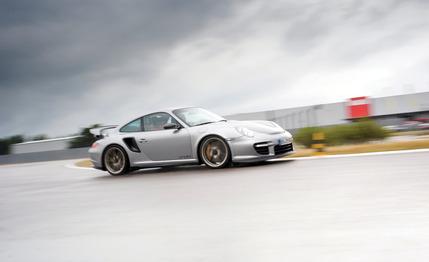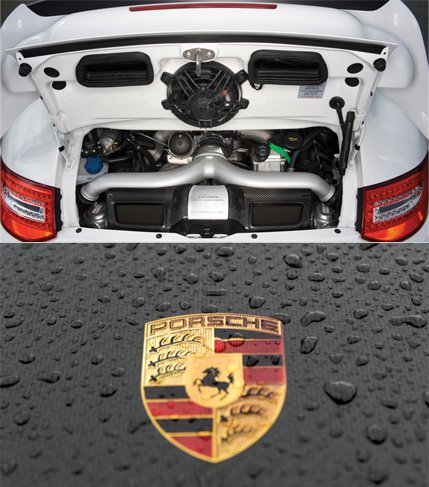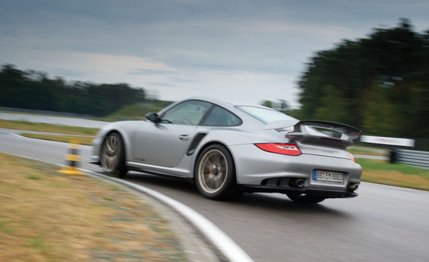 First Drive Review
First Drive Review

Feast your eyes on Porsche’s fiendish self-embrace, a devilish pat on its own back. That’s right, the GT2 RS’s primary reason for being is for the heroic German automaker to reassert itself atop the Nürburgring lap-time pack. And, at 7 minutes 18 seconds—a whopping 14 seconds quicker than the ’08–’09 GT2—it leaves the Corvette ZR1, the Nissan GT-R, the Ferrari 458, the Dodge Viper ACR, and pretty much every other production car in the dust. If you’re still questioning the $167,200 premium over a base 911’s price, also note that the GT2 RS is the first Porsche to one-up the Ring time of another P car, the exotic Carrera GT.
Although the RS suffix (for rennsport, German for “racing sport”) is usually reserved for the street-legal homologation versions of racing models, Porsche defensibly decided that this latest GT2 is hard-core enough to deserve the prestigious label anyway. After all, it’s the most powerful Porsche street car ever and the ultimate, 500-unit send-off for the current 997-generation 911, about a quarter of which will be headed to the United States.
Naturally, horsepower is a component. Dating back to the GT1 Le Mans racer of the late ’90s, the GT2 RS’s twin-turbo, 3.6-liter flat-six was originally a motorsports design and, with constant updating, has been the go-to powerplant for Turbo, GT3, and GT2 models over the past decade. Though it can never match the breathtaking 8400-rpm wail of the naturally aspirated GT3’s engine, this latest boosted variant continues to retain much of the edgy, raspy character that’s often lost in the turbocharging process. It’s a welcome sound overlaid by a 23.2-psi peak hurricane of boost, an increase of 2.9 psi. Along with a more effective intercooler, the GT2 RS achieves 620 horsepower and 516 pound-feet of torque without increasing the 3.6-liter displacement—that’s 90 horses more than the GT2, 120 over and above the current Turbo, 205 more than the 996 Turbo (’01–’05), and a pretty phenomenal 172 horses per liter. Still, the new car is slightly more efficient than the GT2 and is expected to continue to shirk gas-guzzler penance in the U.S.

But even more wowing is the meticulous—almost surgical—150-pound paring of mass throughout the car, adding up to a 3050-pound curb weight that undercuts everything from the 996 GT2 of a decade ago to the carbon-fiber-tubbed Carrera GT. And the GT2 starting point—which had ditched the back seat and featured carbon-ceramic brakes, a titanium exhaust, and various carbon-fiber bits—was already impressive.
Here’s a sampling of the reductions: a single-mass flywheel, 18 pounds (it also seriously hastens the engine’s off-idle response); a carbon-fiber hood (versus aluminum), 5.5 pounds; strategically replacing steel with aluminum for various suspension bits and using two-piece rear springs as well as front springs with fewer coils, 10 pounds; single-lug wheels, 6.6 pounds; swapping the steel hubs of the brake rotors for aluminum, 11 pounds; optional carbon-fiber front fenders (formerly steel), 11 pounds; optional lithium-ion battery, 22 pounds. Porsche even eliminated nine pounds from the carpeting. Working in the opposite direction, U.S.-bound cars have airbag-equipped seats that are 11 pounds heavier (apiece) and rear glass instead of plexiglass, which adds back 8.8 pounds.
The six-speed manual carries over as the lone transmission, with high-effort though extremely positive and precise shifting action intact. Porsche’s dual-clutch PDK doesn’t bolt up to this engine; plus, it would unacceptably undo half of the weight savings.

Front grip is increased by half-inch-wider 19-inch wheels with 10-millimeter-broader (245/35) Michelin Pilot Sport Cup tires. The rears remain 325/30-19s, but the compound has been reworked to match the newfound front bite. A fixed rear spoiler with a 0.4-inch taller lip and extended front air dam help increase downforce by 60 percent. Long a Porsche hallmark is excellent steering, as well as the concerto of mechanical interconnectedness that makes the GT2 a delight to drive. The brake feel is second to none, and the electronically controlled dampers (PASM) take the edge off the firm ride. We found the grip to go away in a predictable fashion, even in the wet—beware of the absurd quantities of power oversteer available, though—but we’ll reserve judgment on the car’s balance until we can explore the GT2 RS’s mountainous limits on drier and more open roads than during our brief drive in Germany.
“It’s not about top speed,” insists project manager Andreas Preuninger, although the GT2 RS will do a gearing-limited 206 mph, 192 of which it deploys during what must be a wonderfully terrifying max-attack Ring lap. Acceleration to 60 mph is also secondary—Porsche would rather quote the claimed 4.1-second improvement from 0 to 300 km/h (186 mph) instead—but should improve by a couple of tenths, to the mid-threes, and continues to be aided by a launch-control system.
And all it took was a little Nürburgring competition, which doesn’t appear to be letting up. How much more can Porsche possibly extract from its rear-engine stalwart?